
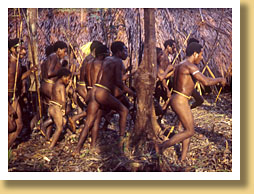 As mentioned before, John traveled to live with this tribe in 1996 and 1998. The highlight of both trips was the gathering of neighboring tribes to the annual feast of the sago palm and its grubs. The feast house is elaborating prepared with fires, utensils, and the harvested supply of grubs wrapped in leaves and then cooked. It is considered a special treat of their diet and serves as a fat supplement to the tribe’s nutrition along with the protein of bugs, the occasional fish or pig.
As mentioned before, John traveled to live with this tribe in 1996 and 1998. The highlight of both trips was the gathering of neighboring tribes to the annual feast of the sago palm and its grubs. The feast house is elaborating prepared with fires, utensils, and the harvested supply of grubs wrapped in leaves and then cooked. It is considered a special treat of their diet and serves as a fat supplement to the tribe’s nutrition along with the protein of bugs, the occasional fish or pig.
June 12, 1998
"From a dead sleep, I heard yelping and walked to the feast house. A strange dance was underway. Again the house was lit by ember of numerous fires and again the best light came when someone blew at the fire or added more fuel and let it flare. The Kombai, like the American Indians do not waste fuel. 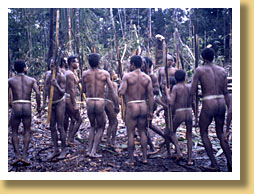 They burn logs at the ends in a circle, slowing feeding them in as they are consumed.
They burn logs at the ends in a circle, slowing feeding them in as they are consumed.
For the dance, one person was dressed like a bird. He had a head band, his arms had straps around them probably made from rat tail with feathers attached….. He had a stick in his band with a long piece of material that resembled loose hemp that he wiggled and it made the sound of bird’s wings. Someone would hold up a torch made of several thin layers of sticks that would flame, so everyone could see. About five other dancers -- in rattan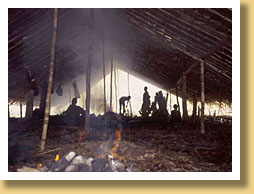 and penis gourds -- would silently follow the leader in step.
and penis gourds -- would silently follow the leader in step.
Then they joined hands and formed a circle – again in silence. Moving in a circle, they began hooting or cawing like birds at which point a group of armed youngsters would charge the circle yelling and hollering. The armed “warriors” stood in place stomping, leaping and hopping with the whole group whooping at the top of the lungs. The lead “bird” would then leave and quietly, in total silence, run to another spot and the circle would break and reform and the scene would repeat against the flickering light of a torch.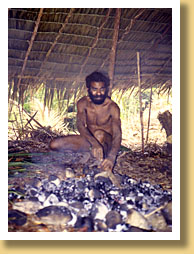
At this point, I was very much of two minds to stay and interact – which is an intense, strange and draining process – or go to bed. It then flashed in my head that I had worked like a mad man for months, left the woman I love, risked my business, flown halfway around the world, walked for days through mud, roots, vines and mosquitoes to experience this primitive world. At that point, I plunged into the center of the feast house, edged my way into a seat by a fire and became part of the feast.
I want to describe where I am sitting. I am on the men’s side of the community hut.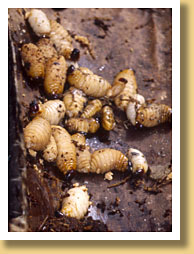 Across from me to my left, on the women’s side is a fire (mostly smoke) two
Across from me to my left, on the women’s side is a fire (mostly smoke) two 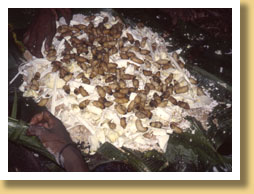 women in hand-woven skirts are putting sago grubs into leaves. They pulled the spines out of the leaves with their teeth to use as ties. The sago worms are wrapped in the leaves and cooked over the fire. Behind the fire on a slightly elevated platform, two small girls are sitting with the little grass skirts and pigs tooth necklaces. An older woman and several dogs are curled up asleep. At the end is a small pig – he is sitting but awake. There is a second smolder fire. On my side several men are sitting with their pipes as well as several small boys. From the roof are carry bags filled with sago for tonight’s feast. In the middle, on the women’s side there are rows of bows & arrows and a fish trap leaning against a grass interior wall.
women in hand-woven skirts are putting sago grubs into leaves. They pulled the spines out of the leaves with their teeth to use as ties. The sago worms are wrapped in the leaves and cooked over the fire. Behind the fire on a slightly elevated platform, two small girls are sitting with the little grass skirts and pigs tooth necklaces. An older woman and several dogs are curled up asleep. At the end is a small pig – he is sitting but awake. There is a second smolder fire. On my side several men are sitting with their pipes as well as several small boys. From the roof are carry bags filled with sago for tonight’s feast. In the middle, on the women’s side there are rows of bows & arrows and a fish trap leaning against a grass interior wall.
Then the group that walked a day and a half to join us was outside the village. There was loud stomping and shouting as they descended on the camp. Our hosts in one band and the visitors in another stomped around with their bows and arrow shouting and hooping in unison. Finally they trooped through the feast house and sat down to eat… The new group held back somewhat and a few clearly had no exposure to white people. You can tell by the size of their eyes as they watched us and quickly turned away. Slowly we got introduced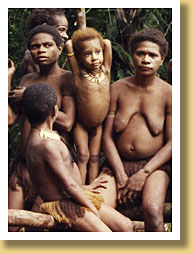 around first by the children and later several of the men did so. Afumarais was quite affectionate when he saw me. He sat next to me with his arm hooked over my leg. He is so shy – but clearly feels very protective of me. I have become ”gray beard” – grandpa by name to several of the men.
around first by the children and later several of the men did so. Afumarais was quite affectionate when he saw me. He sat next to me with his arm hooked over my leg. He is so shy – but clearly feels very protective of me. I have become ”gray beard” – grandpa by name to several of the men.
I was occasionally startled as a harsh flickering torch suddenly lit up the shadowy scene as men strut along the feast house, or sight down arrows, or barter for dog’s teeth, or light pipes. Sago worms and sago are offered around. Others quietly sing or talk together. A dog yelps. The dance continues. A child cries. It is today. It is 15,000 years ago. If there was ever any doubt that we were witnessing traditions whose roots disappear into long ago mists of time – they are gone. We are in the stone age – as the stone age here has been for millennium in this place. These people are so fully adapted into this place and this environment that they would only have changed as the jungle itself has evolved."